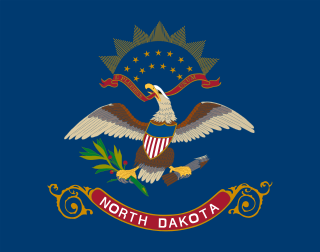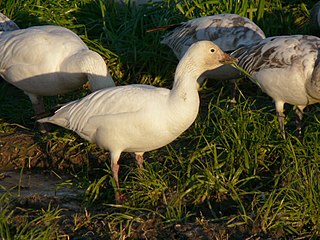Dakota Lake National Wildlife Refuge is a National Wildlife Refuge in North Dakota. It is managed under Kulm Wetland Management District.

National Wildlife RefugeSystem is a designation for certain protected areas of the United States managed by the United States Fish and Wildlife Service. The National Wildlife Refuge System is the system of public lands and waters set aside to conserve America's fish, wildlife, and plants. Since President Theodore Roosevelt designated Florida's Pelican Island National Wildlife Refuge as the first wildlife refuge in 1903, the system has grown to over 562 national wildlife refuges and 38 wetland management districts encompassing more than 150,000,000 acres (607,028 km2).

North Dakota is a U.S. state in the midwestern and northern regions of the United States. It is the nineteenth largest in area, the fourth smallest by population, and the fourth most sparsely populated of the 50 states. North Dakota was admitted to the Union on November 2, 1889, along with its neighboring state, South Dakota. Its capital is Bismarck, and its largest city is Fargo.

Located in south-central North Dakota, Kulm Wetland Management District was established in 1971. Located in the Prairie Pothole Region of North America, Kulm Wetland Management District provides breeding, nesting, and brood rearing areas for many species of waterfowl and other migratory birds. The District currently manages 201 waterfowl production areas that total 45,683 acres (184.87 km2), 3 national wildlife refuges that are easement refuges, and 120,000 acres (490 km2) of wetland and grassland easements. The District's headquarters is in Kulm, North Dakota.
Dakota Lake National Wildlife Refuge was established by Executive Order 8117, signed on May 10, 1939 by President Franklin D. Roosevelt. The Refuge boundaries encompass 2,784 acres (11.27 km2) of private land. A system of flooding easements and management easements allows the Service flood land within the river channel or to restrict hunting, trapping and other harassment of wildlife.

Franklin Delano Roosevelt, often referred to by his initials FDR, was an American statesman and political leader who served as the 32nd president of the United States from 1933 until his death in 1945. A Democrat, he won a record four presidential elections and became a central figure in world events during the first half of the 20th century. Roosevelt directed the federal government during most of the Great Depression, implementing his New Deal domestic agenda in response to the worst economic crisis in U.S. history. As a dominant leader of his party, he built the New Deal Coalition, which realigned American politics into the Fifth Party System and defined American liberalism throughout the middle third of the 20th century. His third and fourth terms were dominated by World War II. Roosevelt is widely considered to be one of the most important figures in American history, as well as among the most influential figures of the 20th century. Though he has also been subject to much criticism, he is generally rated by scholars as one of the three greatest U.S. presidents, along with George Washington and Abraham Lincoln.
An easement is a nonpossessory right to use and/or enter onto the real property of another without possessing it. It is "best typified in the right of way which one landowner, A, may enjoy over the land of another, B". It is similar to real covenants and equitable servitudes; in the United States, the Restatement (Third) of Property takes steps to merge these concepts as servitudes.

Hunting is the practice of killing or trapping animals, or pursuing or tracking them with the intent of doing so. Hunting wildlife or feral animals is most commonly done by humans for food, recreation, to remove predators that can be dangerous to humans or domestic animals, or for trade. Lawful hunting is distinguished from poaching, which is the illegal killing, trapping or capture of the hunted species. The species that are hunted are referred to as game or prey and are usually mammals and birds.
The District manages a low level dam on the James River called Dakota Lake Dam, also known as Ludden Dam or State Line Dam. Dakota Lake Dam was initially constructed by local people and the depression era Works Project Administration to raise the level of the James River, which frequently turned stagnant and toxic to cattle during summer months. The dam raises the level of the James River about one foot which holds water in old river channels, providing breeding, nesting and brood rearing habitat for many marsh dependent birds and other wildlife.

Cattle—colloquially cows—are the most common type of large domesticated ungulates. They are a prominent modern member of the subfamily Bovinae, are the most widespread species of the genus Bos, and are most commonly classified collectively as Bos taurus.

A marsh is a wetland that is dominated by herbaceous rather than woody plant species. Marshes can often be found at the edges of lakes and streams, where they form a transition between the aquatic and terrestrial ecosystems. They are often dominated by grasses, rushes or reeds. If woody plants are present they tend to be low-growing shrubs. This form of vegetation is what differentiates marshes from other types of wetland such as swamps, which are dominated by trees, and mires, which are wetlands that have accumulated deposits of acidic peat.
Dakota Lake National Wildlife Refuge is located in southern Dickey County, North Dakota. From Ludden, North Dakota proceed west on North Dakota Highway 11; the Refuge boundary is at the west end of town. North Dakota Highway 11 crosses the James River and the Refuge.

Dickey County is a county in the U.S. state of North Dakota. As of the 2010 United States Census, the population was 5,289. Its county seat is Ellendale.

Ludden is a city in Dickey County, North Dakota, United States. The population was 23 at the 2010 census. Ludden was founded in 1886.
The James River is at the heart of major corridor for migrating birds. The Refuge is a migration stopover for many thousands of waterfowl and shore birds. Snow geese are one of the most obvious users of the Refuge during their spring and fall migrations. Sand Lake National Wildlife Refuge in South Dakota is a scant 4 miles (6.4 km) south of Dakota Lake National Wildlife Refuge.

The snow goose, consisting of both a white phase and blue phase, is a North American species of goose commonly collectively referred to as "light geese". Its name derives from the typically white plumage. Many taxonomic authorities placed this species and the other "white geese" in the genus Chen. Most authorities now follow the traditional treatment of placing these species in the "gray goose" genus Anser. The scientific name is from the Latin anser, "goose", and caerulescens, "bluish", derived from caeruleus , "dark blue".

Sand Lake National Wildlife Refuge is located in the northeastern part of the U.S. state of South Dakota and is administered by the U.S. Fish and Wildlife Service. Created in 1935, it is a wetlands of international importance and a Globally Important Bird Area. Over 260 bird species are found in the refuge, including many migratory bird species and the world's largest breeding colony of Franklin's gulls.

South Dakota is a U.S. state in the Midwestern region of the United States. It is named after the Lakota and Dakota Sioux Native American tribes, who compose a large portion of the population and historically dominated the territory. South Dakota is the seventeenth largest by area, but the fifth smallest by population and the 5th least densely populated of the 50 United States. As the southern part of the former Dakota Territory, South Dakota became a state on November 2, 1889, simultaneously with North Dakota. Pierre is the state capital and Sioux Falls, with a population of about 187,200, is South Dakota's largest city.
Dakota Lake is closed to all public use; however, hunting, wildlife observation and photography can be quite good on public roads or private lands around the Refuge. April and October are good times to observe waterfowl migrations. An abundance of shorebirds migrate during late August and September.

Photography is the art, application and practice of creating durable images by recording light or other electromagnetic radiation, either electronically by means of an image sensor, or chemically by means of a light-sensitive material such as photographic film. It is employed in many fields of science, manufacturing, and business, as well as its more direct uses for art, film and video production, recreational purposes, hobby, and mass communication.


